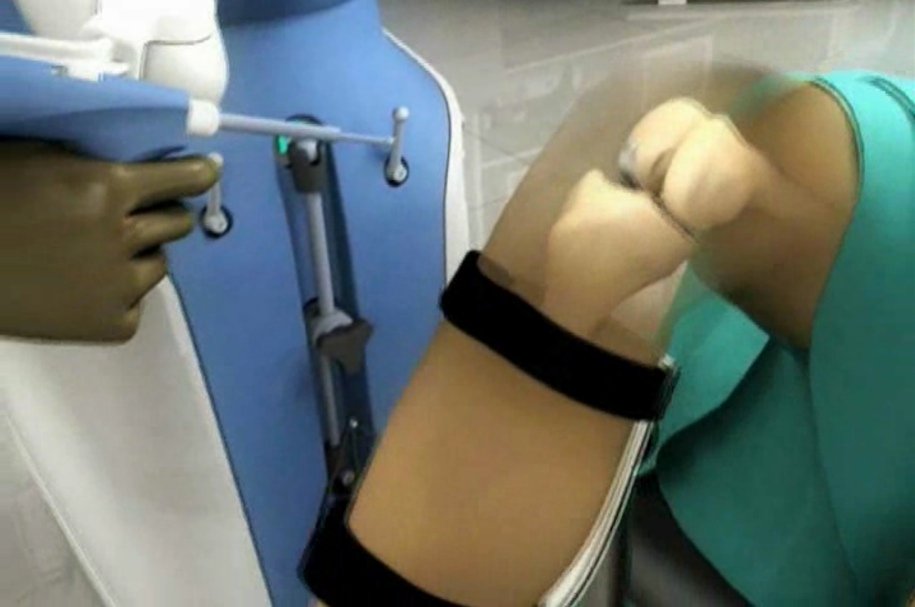
What is Robotic Knee Replacement?
A robotic knee replacement is similar to a traditional knee replacement. Your surgeon removes damaged tissue in your knee and replaces it with an artificial joint. The difference is that it's done with assistance from a robotic arm or handheld robotic device (depending on the robotic system used for your surgery).
Robotic-assisted procedures allow for greater precision and can lead to shorter recovery times and better results. In more complex cases, a robotic-assisted knee replacement offers a better balance in the soft tissues around your knee, and better aligns the joint.
If you're having a robotic-assisted knee replacement surgery, you don't have to prepare any differently than you would for a conventional surgery.
Types of Robotic Assisted Knee Replacements
Penn Orthopaedics has multiple cutting-edge robotic tools:
- The Navio Surgical System
- Mako Robotic-Assisted Knee Surgery
Each system helps your surgeon create an ideal surgical plan for you. This helps optimize every step of your surgery. Your surgeon will discuss all options available to you. While the robotic tools are used to get the same result, they differ when planning and performing your knee replacement.
The Navio and Mako systems can be used in both partial knee replacement and total knee replacement surgeries. Your surgeon will discuss all options available to you, including whether you are a good candidate for robotic joint replacement
Navio System
In conventional knee replacement surgery, plain X-rays, rods and cutting guides are placed on the bone surfaces to ensure proper alignment when planning your procedure.
During robotic-assisted knee replacements, the Navio system takes measurements of the knee, hip, and ankle. Then your leg is moved through a range of motion so the system can see how your leg and knee joint moves. Together, these measurements produce a 3-D image that's specific to your knee. With that image, your surgeon can create a detailed surgical plan and select the optimal implant type and placement.
All this is done in the operating room, where the specialized handheld robotic cutting tool and digital 3-D model of your knee help your surgeon fine-tune your surgery. The Navio complements your surgeon's expertise while evaluating cuts and guiding implant placement and joint alignment
Mako Robot
The Mako system differs from Navio in two key ways:
- It uses specific scans of your knee before surgery to get precise measurements of your knee.
- It takes a slightly different approach to helping your surgeon follow your surgical plan.
Before a Mako knee replacement surgery, you'll get specialized CAT scans that create a 3-D image of your knee joint, bone structure, and surrounding tissues. This detailed picture helps your surgeon plan every step of your surgery. Cuts can be made with precision to the millimeter, picking the right implant size and positioning.
At the beginning of a Mako surgery, your surgeon will use tracking pins to help the robot confirm that it received correct size and positioning information from your CAT scans. Then, the Mako arm positions itself and your surgeon uses the hand-held tool to perform your knee replacement. The tool will guide the surgeon throughout the procedure, enhancing their experience and skills.
Who is a Candidate for Robotic Knee Replacement?
If you are a candidate for traditional knee replacement, it is likely you are a candidate for robotic-assisted knee replacement, as well. It is important that you talk with your doctor to see if surgery – or other non-surgical options to treat knee pain – are best for you.
Robotic knee replacements are ideal for even the most complex knee joint disease. This includes patients who have:
- Deformities in the femur after an injury
- Complex degeneration
- Hardware from previous surgeries
Ligament-Sparing Options
The knee's four ligaments contain special nerves that send the brain information about how your leg is moving and its position in space. This helps your body with movement, acceleration, balance, and more
In a conventional knee replacement surgery, one or two of these ligaments must be removed. While this doesn't impact pain after surgery, it can impact how an artificial knee feels after recovery.
A small number of orthopaedic surgeons — including several at Penn Orthopaedics — can perform traditional knee replacement surgeries that preserve all four ligaments. With the added precision and accuracy from the robotic-assisted knee replacement system, however, this type of surgery is available to more patients than ever before.No other health system or practice in the Philadelphia region offers a ligament-sparing total knee replacement.
Ligament-sparing knee replacements are recommended for patients who:
- Are highly active
- Have healthy bones before surgery
- Have well-functioning ligaments before surgery
What are the Advantages of Robotic Knee Replacement Surgery?
There are several advantages of robotic-assisted knee replacement surgery when compared with traditional surgery. Advantages include:
- 1. Enhanced surgical planning. Depending on the robotic option that is right for you, specialized 3-D images are taken in preparation for or during surgery. These images help your surgeon more accurately plan the optimal type and placement of your replacement joint to ensure the right size and fit.
- 2. Greater precision. Robotic technologies enhance your orthopaedic surgeon's expertise for more precise planning, tissue removal and implant placement. This can cause faster recovery times, fewer complications and a lower likelihood of revision surgery.
- 3. More ligament-sparing options. With the added precision and accuracy from the robotic-assisted knee replacement system, ligament-sparing total knee replacement surgery is available to more patients than ever before
Traditional vs. Robotic Surgery for Knee Replacements
Robotic-assisted knee replacement surgery is not done by a robot alone. Instead, it acts as a guide, helping your surgeon follow the plan laid out in advance. Like during traditional surgery, your orthopaedic surgeon is in control, however, they use the robot as an additional surgical tool. The robot enhances your surgeon's skills during all stages of your surgery to help deliver the best possible outcomes.
